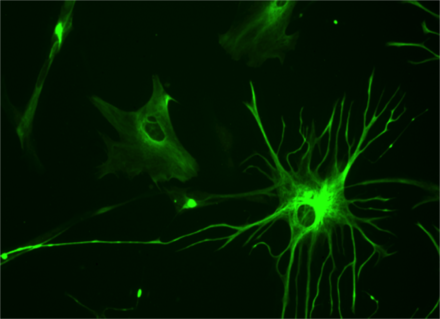Why glial cells should be included in the BRAIN initative
October 2, 2013
[+]
Glia, the non-neuronal cells that make up most of the brain, must not be left out of the Brain Research through Advancing Innovative Neurotechnologies (BRAIN) Initiative, says R. Douglas Fields, chief of the Nervous System Development and Plasticity Section at NIH, in Nature News.
23 week fetal brain culture astrocyte, a type of glial cell (credit: Wikimedia Commons)
“A major stumbling block is the project’s failure to consider that although the human brain contains roughly 100 billion neurons, it contains billions more non-electrical brain cells called glia,” he said.
“These reside outside the neuronal “connectome” and operate beyond the reach of tools designed to probe electrical signaling in neurons. Dismissed as connective tissue when they were first described in the mid-1800s, glia have long been neglected in the quest to understand neuronal signalling. …
“Research is revealing that glia can sense neuronal activity and control it. Various studies also indicate that glia operate in diverse mental processes, for instance, in the formation of memories. They have a central role in brain injury and disease, and they are even at the root of various disorders — such as schizophrenia and Alzheimer’s — previously presumed to be exclusively neuronal. …
“When experts on neuronal plasticity and computational neuroscience came together with glial experts at a workshop in February entitled Glial Biology in Learning and Cognition, held at the US National Science Foundation in Arlington, Virginia, our unanimous conclusion was that neurons working alone provide only a partial explanation for complex cognitive processes, such as the formation of memories.
“The complex branching structure of glial cells and their relatively slow chemical (as opposed to electrical) signalling in fact make them better suited than neurons to certain cognitive processes. These include processes requiring the integration of information from spatially distinct parts of the brain, such as learning or the experiencing of emotions, which take place over hours, days and weeks, not in milliseconds or seconds.”
(¯`*• Global Source and/or more resources at http://goo.gl/zvSV7 │ www.Future-Observatory.blogspot.com and on LinkeIn Group's "Becoming Aware of the Futures" at http://goo.gl/8qKBbK │ @SciCzar │ Point of Contact: www.linkedin.com/in/AndresAgostini
 Washington
Washington